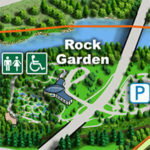| Membership | Price (+HST) |
|---|---|
| Single | $85/year |
| Single Plus | $120/year |
| Family | $130/year |
| Family Plus | $175/year |
| Contributing | $300/year |
| Supporting | $600/year |
| Sustaining | $1,000/year |
| Benefactor's Circle | $2,500/year |
| Director's Circle | $5,000/year |
| President's Circle | $10,000/year |
Mussel Mania: A Rare Find Uncovered at Cootes Paradise
By Sarah Richer, Senior Ecologist, Species at Risk, Royal Botanical Gardens
Exposed mud flats of Cootes Paradise aren’t just good for shoreline clean-ups; they are an opportune time to conduct surveys for freshwater mussels!

The photo to the left shows RBG’s Species at Risk (SAR) Intern Meagan Stager holding an (empty) specimen of the first Mapleleaf mussel ever recorded at one of our specific restoration sites. This achievement is a testament to the progress only made possible by RBG’s team work; the Natural Lands Department, the Admin office, our funders, our volunteers, and our visitors – the work towards cleaner waters and more diverse native terrestrial and aquatic plant communities lays the foundation for the wildlife to return.
RBG’s SAR team obtained a permit to wander our shorelines for the best kind of treasure hunting – looking for SAR mussels among the empty shells left behind by foraging raccoons and muskrats. Staying on the dry shoreline means we leave the sensitive living mussels and their habitat in the water alone.
There are ~51 species of Unionidae (freshwater river mussels) currently recorded in Canada on iNaturalist; and 16 – or one-third of them – are federally and provincially listed SAR; unfortunately, more are being added.
Of the 11 native freshwater mussel species confirmed in RBG’s wetlands, three are listed SAR (Lilliput, Eastern Pondmussel, Mapleleaf), another two are rare (Pink Heelsplitter, NHIC rank S3; and Paper Pondshell, NHIC rank S2), and another that is common in cleaner waters further north in Ontario has not been confirmed alive here for quite some time (Eastern Elliptio).
Monitoring these species’ presence – and absence – over time and across different stretches of shoreline helps us to gauge progress of restoration work, as well as contribute knowledge to this vastly understudied taxon.
For example, using the growth rings on their shells, we were able to back-age other Mapleleaf shells we found to the year after we started restoration work on the adjacent slope and shoreline!


More from the RBG Blog
Check out RBG’s blog for announcements, articles, and more from Canada’s largest botanical garden.
Want to be sure you hear first? Sign up for our weekly e-newsletter to hear about upcoming events, weekend activities, articles, and more!












